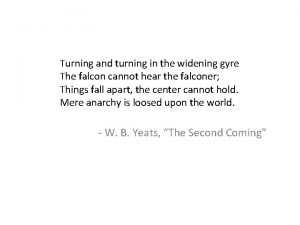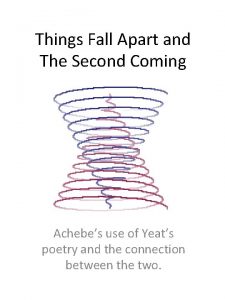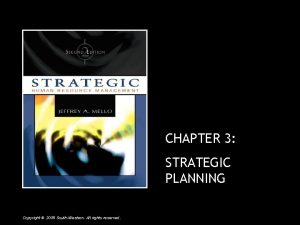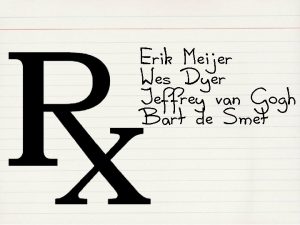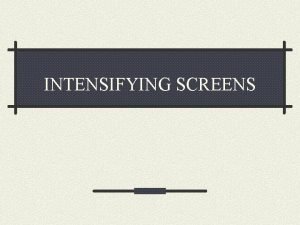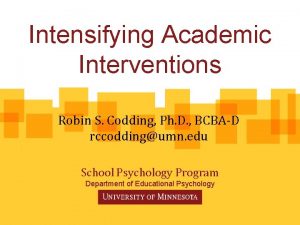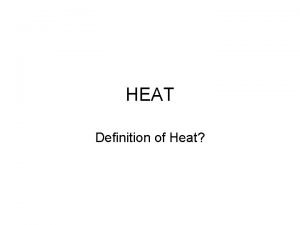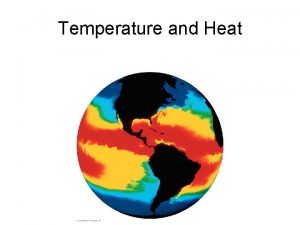Turning Up the Heat Intensifying Interventions Stephanie Dyer




































- Slides: 36

Turning Up the Heat Intensifying Interventions Stephanie Dyer & Melissa Nantais July 31, 2017 miblsi. org

Intended Outcomes • Describe the why, what, and how of intensifying interventions • Define the concepts of Enablers and Core Features to intensifying interventions • Practice applying the concepts of Enablers and Core Features to intensifying interventions 2

Activity 1 • Take 30 seconds to write down a few words or phrases that come to mind when you hear the phrase “Intensifying Interventions” • Share with an elbow partner 3

Non-Examples of Intensifying Interventions • Provide instruction in slower manner • Provide instruction louder • Provide instruction based on “learning styles” • Provide instruction in a specific classroom (e. g. special education classroom) • Just moving into Tier 3 or just for Tier 3 4

WHY intensify instructional & behavioral supports? • To improve our efficiency and effectiveness in producing successful outcomes for students • If we want to close the gap between expected standards and the student’s current level of performance, we need to intensify supports! • We should have a sense of urgency! 5

WHAT of intensifying instructional & behavioral supports? Increasing intensity of supports means increasing the individualization around specific needs: • Precision in identifying the need • Increased focus on addressing the identified need • Increased instruction and engagement • Increased opportunities for practice • Increased frequency and immediacy of feedback 6

HOW of intensifying instructional & behavioral supports? Shifting our thinking around two concepts: • Enablers to intensifying instruction • Core Features to address when intensifying interventions 7

Enablers • Google’s definition of enabler: “a person or thing that makes something possible” • Not sufficient on their own to improve students outcomes, but are the “conditions under which” we can intensify interventions • They set the stage for intensification to happen • Enablers that we will be talking about today: • Time • Grouping • Instructor/Interventionist 8

Rusty Pipe Analogy • Pile of rusty pipes as example of the enabler being the “conditions under which” we intensify interventions. Rust is another name for iron oxide, which occurs when iron or an alloy that contains iron, like steel, is exposed to oxygen and moisture for a long period of time. Over time, the oxygen combines with the metal at an atomic level, forming a new compound called an oxide and weakening the bonds of the metal itself. Time doesn’t cause the rust, but it enables or creates conditions under which the rust develops. 9

Activity 2 • Review the “Allocated Time, ” “Grouping, ” and “Instructor” rows of the Intensifying Supports document • Talk with a partner: • What do you note about the movement of increased intensity? • Do you agree or disagree that moving the dial on time, grouping, and instructor is sufficient to impact student outcomes? Why? 10

Enablers (time): Necessary, but not sufficient • We can increase time spent on instruction, but if we don’t do something different with the increased time, more time will not be enough • Examples: • Attending two Weight Watcher meetings per week instead of one • Retention 11

Enablers (grouping): Necessary, but not sufficient • We can put the student in smaller and smaller groups, but if we don’t do something different within the groups, it will not be enough • Example: • Struggling to learn a dance sequence in class, so moved to a group of 3 • Instructor did same thing as with the whole class 12

Enablers (interventionists): Necessary, but not sufficient • We can provide more skilled instructors or interventionists, but what they do during instruction is what makes the difference • Example: • Needed tutoring in Organic Chemistry beyond the graduate assistant teaching course • Scheduled sessions with expert, but he was unable to define concepts or teach equations in a way that the lay person (I) could understand 13

Las Vegas Investment Scheme • Our efforts in intensifying interventions has historically been a bit like a Las Vegas investment scheme • We put in a coin and expect a big pay-off • Examples: • Presented student with a self-monitoring system (coin) — “Doesn’t work” • Gave student two opportunities to practice responding to arguments during basketball game at recess with a script rather than hitting (coin)–- “Doesn’t work” 14

Activity 3 • Talk at your table: • What are three common enablers that we are talking about? • Are enablers necessary for intensifying interventions? Why or why not? • Are enablers sufficient for intensifying interventions? Why or why not? 15

• Whatordo we So within time, grouping, and instructor, we have continuums. We can decrease need to do? increase time, make groups larger or smaller, and adjust the instructor by experience/skill level. So if doing this just sets the stage or creates conditions under which we can intensify interventions, but alone they are not sufficient to intensify interventions, what do we need to do? ? If these are not sufficient to intensify interventions, then… WHAT DO WE NEED TO DO? ? 16

Let’s Layer on “Core Features” • Necessary to intensifying interventions • Critical to improving outcomes • Enhanced by enablers • Core Features that we are talking about today: • • Precision Engagement Feedback Practice 17

• So, for example, we now know that increasing time (enabler) is not sufficient. So what do we do with the increased time? We get more precise about the problem or skill, we increase engagement, we increase practice or opportunities to respond, and Adding core features we increase the frequency and specificity of feedback. Same with grouping. Making the group size smaller is not enough, but it creates the conditions under which we can get more precision, increase engagement, increase practice, and increase the specificity and frequency of feedback. Same with the enabler of the instructor. 18

Activity 4 • Review the Core Features rows of the Intensifying Supports document • Talk with your table: • What do you note about the movement of increased intensity? 19

What Does This Look Like Applied Within Tier 1 and Tier 2? Core Features Contexts 1. Precision 1. Classroom—all students 2. Engagement 2. Classroom—few students 3. Practice 3. Classroom—one student 4. Feedback 4. Check-In, Check-Out intervention 20

Activity 5 • Stand up! • Find someone from across the room to partner with • Partner 1: Choose a Core Feature • Partner 2: Choose a Context • Together, create an example of how the core feature can be applied within that context to intensify intervention • Be ready to share out 21

Activity 6 • Count off by 2’s at your table • Do a 30 second quick write: • 1’s: Define/Describe Enablers • 2’s: Define/Describe Core Features • Take turns doing a Stand Deliver to read your description to your team 22

Putting it all Together So, how do Enablers and Core Features of intensifying interventions work together? 23

Layer it! Here are the Enablers and Core Features layered together! Just a visual to show that the Enablers create the conditions for intensification to occur, but the Core Features need to be layered onto Time, Grouping, and Instructor to actually change outcomes for kids. The next few slides will play this out in a real life example. One way to think about this is viewing this visual as a big soundboard. We need a little more practice, need to adjust the grouping, whoops! It’s squawking…need a little less feedback, etc. 24

Let’s Walk Through a Scenario • Second Step Curriculum (social skills training) was used in the classroom for all students • Some students required more support as they were not displaying the new skills, so they were put into a small group and provided additional time to be re-taught the skills from the Second Step Curriculum by the school psychologist 25

Activity 7 • What enablers or core features are present in this example of intensifying interventions? • Is this plan sufficient to close the gap between expected standards and current level of performance? • Why or why not? 26

Let’s continue… • Within the small group, the school psychologist identified the specific skills and features of the skills that the students were lacking and provided additional instruction to address the gap • Students had 20 -25 opportunities to practice the new skills within a group session • The psychologist provided immediate, explicit feedback on each practice of the skill and provided correction and modeling when eneded 27

Activity 8 • What enablers or core features are present in this additional example of intensifying interventions? • Is this plan sufficient to close the gap between expected standards and current level of performance? • Why or why not? • What else might you add to this plan to provide further intensification? 28

Activity 9 • With a partner at your table, select one of the two scenarios on the Scenarios handout • Identify which enablers and core features are currently present and determine whether or not these are sufficient to move the dial for this student and why/why not • If insufficient, what else would you add to this plan to intensify the intervention? • Be ready to report out 29

Agree or Disagree 1 Within an MTSS/PBIS framework, each additional tier of support is intended to be layered onto the previous tier of support, rather than replace it 30

Agree or Disagree 2 Intensifying interventions is defined by the specific person, intervention program and location of the intervention supports provided 31

Agree or Disagree 3 Increasing the amount of time a student is in intervention and providing a double dose of an intervention lesson are considered core features of increasing intensity of intervention 32

Agree or Disagree 4 The Enablers (time, grouping, and interventionist) are necessary, but not sufficient, to intensify interventions 33

Agree or Disagree 5 Intensifying interventions through use of Enablers and Core Features can be applied at all three tiers of support and for ALL students 34

Activity 10 • Key Word: Write down two key words from our session • Important Information: Write down important information about your key words. What do you know? What connections can you make? • Device: Create a visual or memory device to help you remember Be prepared to share with the group! 35

Session B Clock Hours Code TUh. B It is the responsibility of each participant to document his/her own attendance. Missed codes cannot be repeated or shared. 36
 Surely the second coming is at hand
Surely the second coming is at hand Turning and turning in the widening gyre
Turning and turning in the widening gyre Poem things fall apart
Poem things fall apart The unbecoming of mara dyer summary
The unbecoming of mara dyer summary Dyer and holder typology of strategies
Dyer and holder typology of strategies Melanie combs dyer
Melanie combs dyer Dbning
Dbning Weaver canterbury tales
Weaver canterbury tales Meijer poker chips
Meijer poker chips Lin and dyer
Lin and dyer Gillian dyer
Gillian dyer John dyer rainforest
John dyer rainforest Hobo dyer map pros and cons
Hobo dyer map pros and cons What does intensifying mean
What does intensifying mean Stages of coming together
Stages of coming together Reflective layer of intensifying screen
Reflective layer of intensifying screen Dentistry
Dentistry Specific heat capacity graph
Specific heat capacity graph Specific latent heat
Specific latent heat Combination method of cooking
Combination method of cooking Tỉ lệ cơ thể trẻ em
Tỉ lệ cơ thể trẻ em Lời thề hippocrates
Lời thề hippocrates Vẽ hình chiếu đứng bằng cạnh của vật thể
Vẽ hình chiếu đứng bằng cạnh của vật thể đại từ thay thế
đại từ thay thế Quá trình desamine hóa có thể tạo ra
Quá trình desamine hóa có thể tạo ra Công thức tiính động năng
Công thức tiính động năng Môn thể thao bắt đầu bằng từ chạy
Môn thể thao bắt đầu bằng từ chạy Sự nuôi và dạy con của hươu
Sự nuôi và dạy con của hươu Thế nào là mạng điện lắp đặt kiểu nổi
Thế nào là mạng điện lắp đặt kiểu nổi Hát kết hợp bộ gõ cơ thể
Hát kết hợp bộ gõ cơ thể Các loại đột biến cấu trúc nhiễm sắc thể
Các loại đột biến cấu trúc nhiễm sắc thể Thế nào là sự mỏi cơ
Thế nào là sự mỏi cơ độ dài liên kết
độ dài liên kết Gấu đi như thế nào
Gấu đi như thế nào Thiếu nhi thế giới liên hoan
Thiếu nhi thế giới liên hoan điện thế nghỉ
điện thế nghỉ Một số thể thơ truyền thống
Một số thể thơ truyền thống

